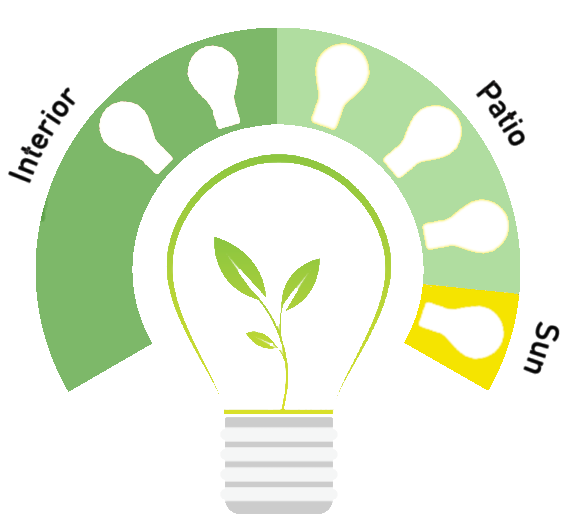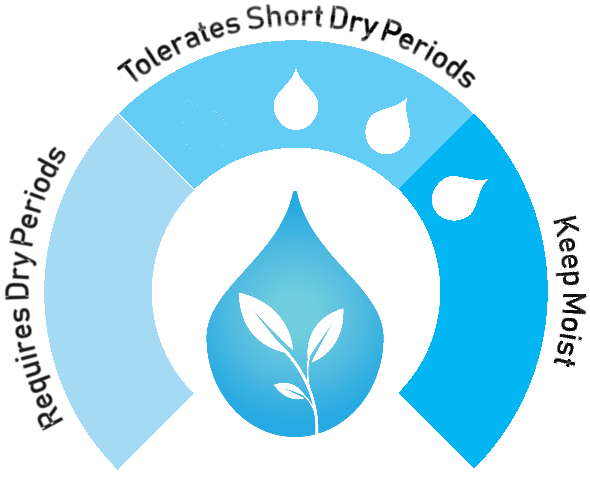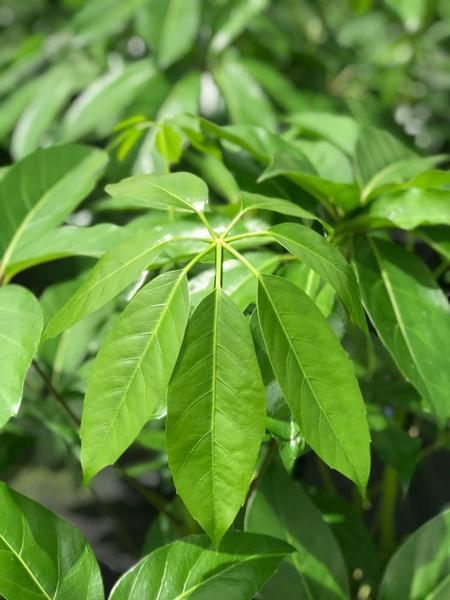
The Amate has been around for a long time and for good reason. You will need a bright environment to keep this houseplant looking its best. When happy, the umbrella plant has huge green shiny foliage. We grow the Amate in 10 to 17 inch pots with heights ranging from 36 inches to 10 feet. The larger 17 inch can range from 8 feet to 11 feet.
The meters below indicate a range of light and tolerance to drought. The ranges are indicated by the little light bulbs and the small water drops.
Light Instructions

Water Instructions


From the Grower:
The Schefflera 'Amate' is liked by humans and insects alike. Indoors the insects to watch out for are mealybugs and mites. Mealybugs will cause severely disfigured leaves. It is often difficult to find mealybugs on Amate since they hide in the enclosed space where the leaf petiole attaches to the main stem. As the problem progresses, you can find live mealybugs on the bottom of leaves. Gently peal back the pointed petiole sheath that hugs the stem to inspect for suspected mealybugs. As mites begin to feed on Amate the newer leaves will develop light tan colored spots visible from the top of the leaf. Inspect the underside of these leaves for live mites or indications of mites.
Mealybugs can be removed with a systemic insecticide drench and hand cleaning. If pesticides are not an option, try horticultural oil directly sprayed onto the insects. A second and third treatment, if using oils, will be necessary. Space out the sprays at 3 week intervals to break up the mealybug life cycle. Spraying the entire plant is not as effective as spot spraying where the mealybugs are. Removing mealybugs from an Amate is difficult without a systemic pesticide drench because the mealybug hiding places are protected from sprays and not easy to inspect. Remove what you can see, spot spray if you find the insects and drench with something like Safari or Altus. These systemic insecticides can provide 3-5 months of protection against mealybugs.
Mites should be primarily controlled with predator mites. Neoseiulus californicus,(Spical, Spical Plus, Californiline) and Phytoseiulus persimilis,(Spidex, Bio Persimilis, Phytoline) are two excellent choices for spider mite control. If a mite infestation is exceptionally bad, prior to the release of predator mites, spray the plant with water or horticultural oil. Both will provide some knockdown control of spider mites and will not leave a toxic residue that may effect predator mites. If the population of spider mites is red in color, (as opposed to pale yellow with 2 dark black spots) then californicus mites are the only option. Even these predators do not feed heavily on the red spider mite. In this case spraying is the best option. Use a miticide that works well with californicus predator mites (Sultan, Floramite SC, Shuttle O).
Aphids can be controlled in the same way as mealybugs. Alternatively the aphids can be sprayed directly with a large number of pesticides that are labeled for aphids. Aphids are easily visible and will be located on the soft new foliage. The newest leaves are usually below the canopy, so don't miss those.
Watch for drooping foliage to indicate water stress. Severe water stress will result in yellow older leaves. When the fertilizer and water are correct, an Amate will have a shiny appearance. Too much water for an extended duration can cause root damage. Dull and droopy foliage when the plan has plenty of water indicate root loss. Let the soil dry, move to a bright location and try to rehabilitate the plant.
Sansevieria Wintergreen
Schefflera actinophylla 'Amate'
Strelitzia nicolai 'White Bird'
